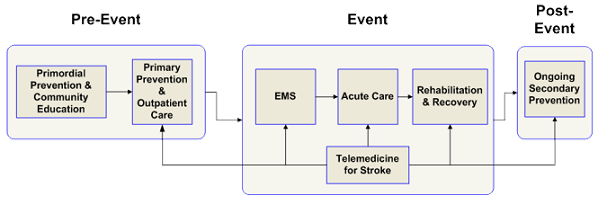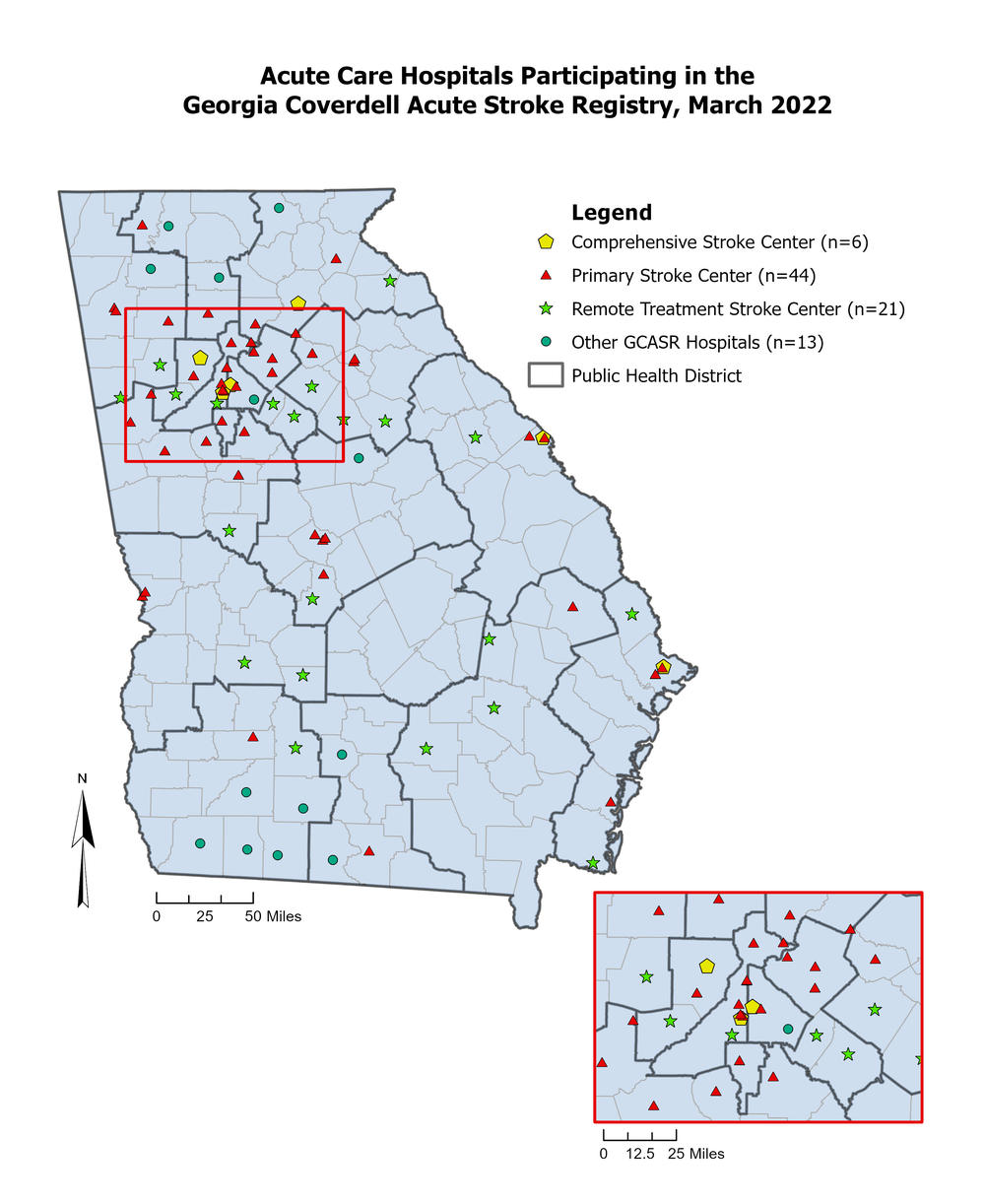
Georgia Coverdell Acute Stroke Registry
Reports | Archived Reports | Videos
Participating Hospitals | Stroke Conference
PROGRAM HISTORY
Named in honor of the late Senator Paul Coverdell of Georgia, who died of a massive stroke in 2000, the primary goal of the Georgia Coverdell Acute Stroke Registry (GCASR) program is to improve the care of acute stroke patients in the hospital and pre-hospital settings. The program is funded by the Centers for Disease Control Paul S. Coverdell National Acute Stroke Registry cooperative agreement and was established in 2001 as a prototype project implemented by the Emory University School of Medicine. Full implementation and incorporation into the State’s Department of Public Health (DPH) began in 2005.
PURPOSE
This program addresses quality improvement in multiple areas of stroke care, from rapid screening, diagnosis, and intervention for patients experiencing an acute stroke, to secondary prevention measures such as blood pressure control, smoking cessation, and treatment of elevated cholesterol to reduce the incidence of recurrent stroke after hospital discharge. In addition, the program will also help improve the use of rehabilitation services for those who have experienced an acute stroke, in an effort to reduce long-term disability due to stroke.
States in the southeastern U.S. have the highest incidence and mortality of stroke; as a result, this area of the U.S. is commonly referred to as the stroke belt. In an effort to reduce long-term disability, the GCASR and the State of Georgia Cardiovascular Health Initiative Program work to reduce heart disease-and stroke-related morbidity and mortality in Georgia.
View the following videos:
Coverdell Stroke Program: Ensuring that All Americans Receive the Highest-Quality Care
Dr. Frankel’s Coverdell Story: Improving Stroke Care in Georgia
GOALS
Increase Quality Improvement through collaborative efforts among participant hospitals, EMS agencies and Rehabilitation facilities
Lower the stroke morbidity experienced in Georgia.
Enhance the effectiveness of secondary care and prevent recurrent strokes.
Develop protocols to guide clinical care with effective stroke management.
Develop effective methods to care for acute stroke patients.
The Components of Stroke System of Care

PARTICIPATING HOSPITALS

As of December 2021, 83 hospitals participate in the Registry, which provide a coverage close to 96% of the annual acute stroke admissions in Georgia. GCASR plans to enroll more hospitals in the coming years.
BENEFITS OF PARTICIPATING IN THE REGISTRY
Benefits for the participating hospitals and Emergency Medical Services (EMS) agencies, and their patients include:
Monthly registry-wide telephone conference calls with participating hospitals, EMS agencies and GCASR staff
“Kickoff” workshop for new participants
Annual regional data abstraction training workshops
Quarterly GCASR newsletters
Annual meetings to exchange best practices
Quality improvement consultant to work with hospital staff on-site or by telephone
Encouragement to hospitals to network with one another
Great resources and mentoring for hospitals needing specific stroke related information
Georgia Coverdell Champion Hospital of the Year Awards
Opportunity to contribute to improve stroke care quality statewide
In addition, training in Advanced Stroke Life Support through the University of Miami’s ASLS Emergency Medical Skills Training Course is provided to hospital and EMS staff at no cost. This training teaches emergency assessment and management of acute stroke to all levels of healthcare providers, from EMS personnel to hospital and emergency department nurses and physicians.
The Registry benefits patients directly by offering real-time feedback to hospitals that covers patient-related Quality of Care Indicators . Selected patient care information on each stroke admission is entered into an online data collection tool. Real-time analysis provides feedback to each hospital related to the quality of care that their patients are receiving. Hospitals can also compare their performance on quality indicators with other hospitals using the American Heart Association’s Get With The Guidelines - Stroke database. Up-to-date guidance on standards of care is provided to caregivers through the online tool as well. In addition, patient education resources, published by the American Stroke Association and by the Georgia Department of Public Health (DPH), are available to the patient or hospital. Improvements in quality of care are tracked regularly by the GCASR and feedback is provided back to the hospitals related to their Quality Indicator performance.
PARTNERS
The Georgia Coverdell Acute Stroke Registry is a partnership among a number of groups and organizations, all of whom have the goal of improving the quality of care of acute stroke patients in Georgia, with the ultimate hope of reducing the deaths and disability due to stroke for all citizens in Georgia. Currently, our partners include:
Georgia Hospital Association
Georgia Medical Care Foundation
Georgia Stroke Professional Alliance
HOSPITALS INTERESTED IN PARTICIPATING
Please contact;
Georgia Department of Public Health
Quality Improvement Consultant
or
Georgia Department of Public Health
GCASR Program Coordinator
RESOURCES
The Georgia Coverdell Acute Stroke ECHO provides a virtual community learning platform for providers and first responders to access stroke specialist(s), discuss challenging cases, barriers and solutions to improve the stroke system of care in Georgia.
This site provides professional resources for systems development for stroke care and pathways for the rapid diagnosis and treatment of acute stroke, as well as links to patient resources that provide helpful information to stroke patients, their families, and their caregivers.
Behavioral Risk Factor Surveillance System (BRFSS)
Centers for Disease Control and Prevention, Stroke – Home Page
Guidelines for Early Management of Adults With Ischemic Stroke
Guidelines for the Management of Spontaneous Intracerebral Hemorrhage in Adults: 2010 Update
Guidelines for the Primary Prevention of Stroke: 2011 Update
Data are available for Georgia state-wide as well as by Health District. Click here for Georgia Data.
Page Last updated 04/17/2024